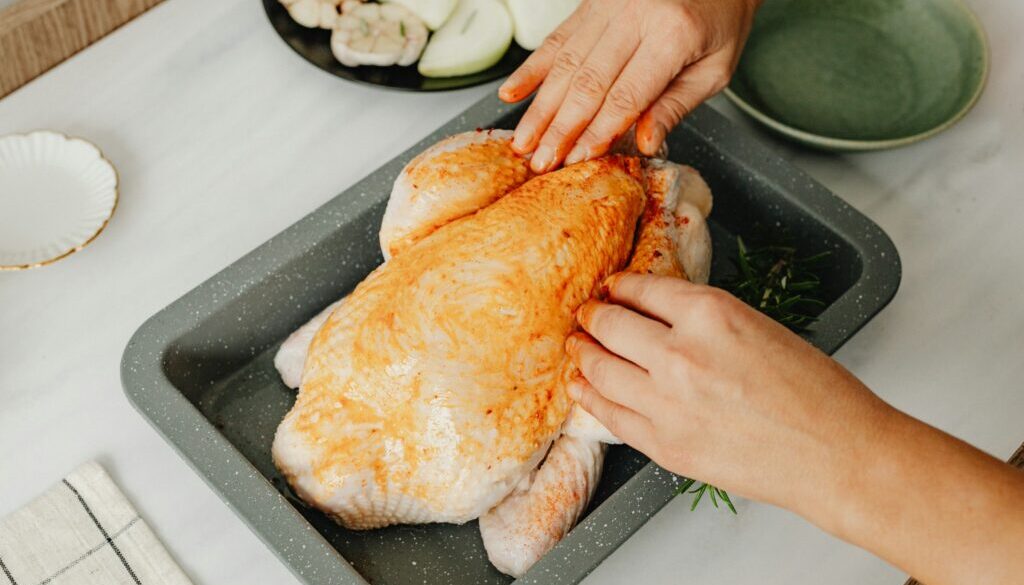USDA withdraws proposed rule meant to reduce Salmonella in poultry products
Federal regulators on Thursday withdrew a proposed framework for raw poultry products that was introduced under the Biden administration to reduce the spread of Salmonella bacteria, one of the leading pathogens involved in foodborne illness outbreaks.
The rule, proposed by the Food Safety and Inspection Service (FSIS) under the US Department of Agriculture (USDA) in August 2024, would have declared chicken and turkey products spoiled if they contained 10 or more colony-forming units of the bacteria and if they were contaminated with Salmonella strains that are considered particularly concerning for human health.
“The Biden-era proposal would have imposed significant financial and operational burdens on American businesses and consumers, failing to consider an effective and achievable approach to address Salmonella in poultry products,” said a USDA spokesperson.
FSIS will work to assess its approach to addressing Salmonella in poultry products in ways that won’t “impose regulatory burdens on American producers and consumers,” said the spokesperson, including by evaluating whether an update to the current Salmonella standards is warranted.
The announcement comes after some US lawmakers introduced a bill earlier this year aimed at preventing the USDA from implementing the framework. The move to axe the proposed rule also comes on the heels of the US Food and Drug Administration (FDA)’s announcement last month to delay by 30 months the implementation of a rule designed to help the agency quickly find contaminated foods and remove them from the supply chain.
The Trump administration also recently terminated two USDA food safety advisory committees, including one that was researching how to better predict and control foodborne pathogens, including Salmonella.
While industry groups said the now-scrapped framework lacked scientific rigor and would have increased chicken prices, health advocates called Thursday’s move a step backwards for efforts to protect public health.
The USDA’s decision to withdraw the proposed Salmonella framework is “disappointing and troubling,” Brian Ronholm, director of food policy at the nonprofit research and advocacy group Consumer Reports, said in a statement. Combined with recent federal staff and budget cuts and other food safety regulatory changes, “the administration is sending the message that consumers will be on their own when it comes to protecting their families from foodborne illness,” he said.
“Salmonella infections from poultry have increased steadily over the past decade and sicken hundreds of thousands of Americans every year,” said Ronholm. “Consumers deserve better safeguards against Salmonella and other threats to our food supply.”
FSIS received over 7,000 comments on the proposed Salmonella framework before the comment period closed on January 17.
In its comments, the nonprofit watchdog and consumer advocacy group Center for Science in the Public Interest called the framework a “positive groundbreaking shift in the agency’s approach to Salmonella in raw poultry.”
“The proposal is estimated to prevent between 765 and 4,300 illnesses per year and cost no more than $0.0005 per pound of chicken produced, about five hundredths of a penny, an amount too small to be detectable in the grocery store,” the group wrote. “Clearly, the health of American families is worth this much.”
The group added that it wished the framework would go further, expressing concerns that it did not include limits for a subtype of the bacteria called Salmonella Infantis, “a leading cause of poultry-associated outbreaks that is frequently multidrug resistant,” and that it did not address risk from less common types of the bacteria linked to outbreaks.
“America’s chicken producers remain committed to further reducing Salmonella and fully support changes in food safety regulations that are based on sound science, robust data, and are demonstrated to positively impact public health,” Ashley Peterson, senior vice president of regulatory and scientific affairs for the National Chicken Council industry group, said in response to the proposed rule in a January statement. “We are concerned this proposal is not based on any of these.”
The framework risked increasing the price of chicken without offering health benefits, said Peterson, adding that properly cooking and handling chicken ensures it is safe to eat and that Salmonella rates from chicken are at “all-time lows.”
The FDA is reportedly investigating two new Salmonella outbreaks that together have sickened over 70 people. The agency is tracing the origins of the outbreaks.
A Consumer Reports analysis in February found that 57 poultry facilities across 26 states fit the FSIS definition for worst-performing plants based on Salmonella test results, with results that are higher than the maximum allowable levels for the bacteria. The designation means that Salmonella contamination at the plants is “very difficult” to control, according to the report.
Hospitalizations and deaths from foodborne illnesses more than doubled last year compared to 2023, according to a recent report by the US PIRG Education Fund, with almost all illnesses in reported outbreaks caused by Salmonella, E. coli and Listeria.
(Featured image by Karolina Grabowska via Unsplash.)
 EWG
EWG


